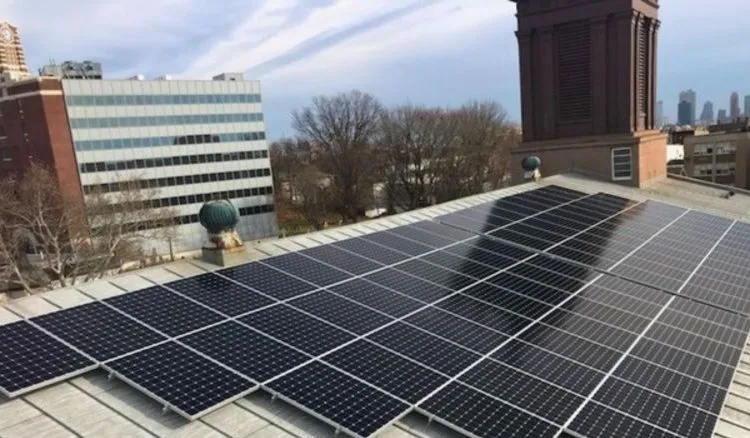

After installing solar panels, Old Bergen Church in Jersey City saves at least $10,000 in utility costs and earns about $8,000 yearly via SREC credits. (Source: Pastor Jon M. Brown)
By Nicola A. Menzie| Managing Editor, Faithfully Magazine
This story was produced in collaboration with CivicStory and the NJ Sustainability Reporting project.
New Jersey has made community solar permanent after deeming its two-year Community Solar Pilot Program a success. That means more than 1.2 million renting households, half a million low-income residents, and others who cannot afford solar panel installations will also be able to reduce their carbon footprint and energy bills.
It was welcomed news when the New Jersey Board of Public Utilities (NJBPU) announced that the pilot program was moving forward as the Community Solar Energy Program. In addition to serving renters, underserved communities of color, and energy-burdened residents, the community solar program ultimately works toward achieving Gov. Phil Murphy’s goal of using 100% clean electricity by 2035.
Solar in New Jersey
The Solar Energy Industries Association (SEIA), a national trade association, ranks New Jersey eighth nationally for solar generation. More than seven percent of New Jersey’s energy comes from solar.
As for community solar, New Jersey is among 41 states, plus Washington, D.C., currently offering the shared renewable energy program. However, only about half of those states have policies to encourage community solar growth.
In its latest report, the NJBPU lists 181,082 solar installations with a capacity of nearly 4,500 megawatts through June. Among the total installations are 27 community solar projects totaling 48.9 megawatts.
For perspective, the average New Jersey home uses nearly 9,000 kilowatts (0.09 megawatts) of electricity a year, according to the U.S. Energy Information Administration.
“The completed projects are currently serving more than 6,000 New Jersey subscribers,” according to the NJBPU. The board claims subscribers had “a net savings of more than $1 million since the start of the Pilot through February 2022.”
Assuming the 6,000 subscribers are renting households, less than 1% of this population used community solar during the noted timeframe.
However, 99 additional community solar installations are said to be in the pipeline, with a total capacity of 161 megawatts.

A solar parking canopy at Stockton University in Galloway Township, N.J. (Photo: Flickr CC/Bob Pegnato)
What Is Community Solar?
Community solar is a shared renewable energy program that allows residents to use sun-generated electricity from an off-site location to power their homes. Customers who participate in the program receive a bill credit for the excess energy generated by the shared solar installation. The bill credit, a portion of which covers the subscription fee for the program, appears on the monthly bill sent by Public Service Electric and Gas, Atlantic City Electric, or whichever utility company services the subscriber’s area.
Although community solar is primarily associated with households, the program is also open to businesses and other entities. Essentially, anyone who wants to transition to the clean energy source but cannot install solar panels due to cost or location can do so via community solar.
The physical solar installations (sometimes called solar gardens or solar farms) are typically situated on the roof of a local building such as a warehouse, business, or church. However, community solar installations in New Jersey are also sited at landfills, brownfields (polluted sites), and even at a former sand and gravel pit, according to NJBPU reporting data.
Community Solar in New Jersey
Community solar helps renters and others experience the benefits of renewable energy long enjoyed by homeowners, who account for more than 63% of New Jersey’s population.
In New Jersey, there are more than 1.2 million renter households, and many of them are rent- and energy-burdened (an excessive amount of the household income is spent on rent and energy expenses). The state’s Community Solar Energy Program is intended to help address some of those burdens.
Community solar programs in New Jersey must keep special considerations in play for low- and moderate-income (LMI) residents. This was an initial requirement for the pilot program as mandated by the state’s 2018 Clean Energy Act to ensure equitable access to community solar. The Solar Act of 2021 reaffirmed those requirements.
Under the pilot program, 40% of the community solar program capacity was reserved for LMI subscribers. The permanent program recommends that at least 51% of a project’s customer base be LMI subscribers.
Residents interested in signing up for community solar can use a search tool provided by the NJBPU and the Sustainable Jersey organization to identify local projects available to them. Users type in their zip code, and a list of public projects loads on the page. For example, a search using Newark zip codes results in a list of two community solar projects with details about their capacity, location, estimated customer savings (currently 22-25%), and so forth.
The counties with the most community solar project installations currently are Middlesex (8) and Hudson (4), while several counties have yet to see any installations.

A factory smokestack in New Jersey emits pollutants into the atmosphere. (Flickr CC/UN Photo/John Isaac).
Community Solar Benefits
In addition to saving money on their electricity bills, community solar subscribers help reduce local greenhouse gas emissions, which are among the leading causes of climate change.
New Jersey is home to major highways, a busy airport, and dozens of power plants, so air pollution is a major concern. The American Lung Association cites New Jersey residents as at risk for several lung diseases, including asthma and lung cancer. The risks are compounded for those living in poverty and for people of color.
New Jersey community solar projects are limited to 5 megawatts. According to the Environmental Protection Agency’s greenhouse gas calculator, the limit is equivalent to avoiding producing nearly 8,000 pounds of carbon dioxide.
In addition to combating climate change, community solar can translate to more jobs. Owners and operators of community solar programs often hire local installers for their projects, which boosts the local economy.
Community Solar Challenges
Community solar may sound like a no-brainer, but there are challenges to the shared renewable energy program. For example, utility companies do not want the program open to third-party developers, citing concerns about these companies potentially putting profits over people. Conversely, utility companies have been accused of greed in their desire to own and operate all community solar programs in New Jersey.
The NJBPU addressed these concerns in its most recent draft of the Community Solar Energy Program proposals. It determined “that the [electric distribution utility companies] not be permitted to develop, own, or operate community solar projects.”
Another challenge to community solar is the pace of rollout. Although 150 projects were approved during the pilot program, less than 30 are up and running. As noted in the example above, Newark, the state’s most populous city, currently has only two site subscription options for community solar. However, two additional projects are scheduled to become available to the city’s nearly 314,000 residents by the end of the year.
A final potential challenge to the Community Solar Energy Program is awareness. For the program to be successful and serve its stated purpose — supporting energy equity among residents — the public has to know it exists. There has been no mass public awareness campaign to inform residents, particularly LMI households, about community solar. However, the public utilities board has recommended that shared solar project developers submit a “Community Engagement Plan” with their project applications moving forward.
“Educational campaigns through advertisements and collaboration with community organizations are valuable methods to promote community solar energy,” the NJBPU said in its proposals for the permanent Community Solar Energy Program.
Conclusion
New Jersey is on course to rely less and less on fossil fuels and more on renewable energy sources like solar. While homeowners have long benefited from the advantages of solar, community solar programs are expected to make access more equitable.
Federal incentives, including the Inflation Reduction Act, will likely bolster developers’ continued interest in expanding community solar projects in New Jersey and elsewhere. In the meantime, residents can check the New Jersey Board of Public Utilities website for developments on the program’s policies and find community solar projects in their area.
This story was produced in collaboration with CivicStory as part of the New Jersey Sustainability Reporting project. Find more stories like this at the New Jersey Sustainability Reporting Hub.
